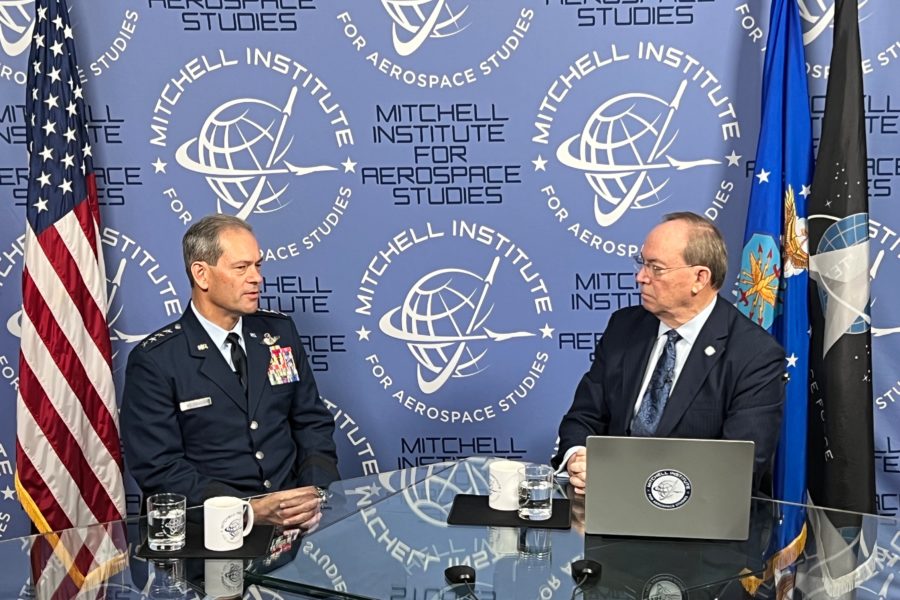Give Gen. Kenneth S. Wilsbach, commander of Pacific Air Forces, one extra dollar, and he would spend it bolstering U.S. air superiority in the region.
Speaking at an Aerospace Nation event hosted by AFA’s Mitchell Institute for Aerospace Studies, Wilsbach said March 20 that air superiority is a joint endeavor of the U.S. and its allies in the region, and includes everything from combat jets to tankers, airlifters, and intelligence, surveillance, reconnaissance, and command and control assets like the E-7 Wedgetail.
“It starts with the E-7,” Wilsbach said. “Having domain awareness is important. [The reason] why we need the E-7 so badly is because our current fleet of E-3s are challenged remarkably, just getting them in the air.”
The E-3s now average more than 42 years old and are based on a Boeing 707 airframe that is hardly in use anywhere any longer.
“Our maintainers are doing great work to keep those things in flying order, but [the aircraft] are old and they take a lot of maintenance to keep them in optimal condition,” Wilbach said. “And then the other fact is “Even when they’re perfectly in order and they get airborne, they don’t necessarily see what they need to see in the 21st century modern warfare. The E-7 does … and so the E-7 is absolutely critical.”
The Air Force is contracted with Boeing to supply the E-7 and anticipates getting the first aircraft in 2027. To prepare its first E-7 crews, USAF is working with the Royal Australian Air Force, which already flies the airframe, Wilsbach said, giving U.S. Airmen a “sneak peak” at the Wedgetail now and over the next several years.
“This sharing of tactics, techniques and procedures between the allies and partners only makes them stronger,” Wilsbach said. “Exercising on a very frequent basis helps us to be interoperable.”
USAF is also working with the Australians on developing Collaborative Combat Aircraft, the semi-autonomous drones that will fly alongside crewed fighters in the future, adding combat mass and new capabilities. The Royal Australian Air Force worked with Boeing to develop its MQ-28 Ghost Bat, which is similar to the U.S. CCA concept.
“We really look forward to what they’re doing with the MQ-28 Ghost Bat there,” Wilsbach said. “They are doing some great work figuring out exactly how to use this aircraft and we look forward to seeing what they learned and then perhaps applying that to our CCA program ourselves.”
U.S. Air Force Secretary Frank Kendall said two weeks ago the service envisions a notional fleet of 1,000 CCAs—or even as many as 2,000—to help deter, and if necessary, fight the substantial forces of China in the Pacific. Wilsbach acknowledged that in a peer fight like that, the Air Force must anticipate significant losses, so mass will make a difference.
“The ability to create dilemmas and mass up those dilemmas on your adversary causes them to make mistakes, it causes them to use weapons, and it eventually will cause them to lose their assets versus us,” Wilsbach said.
CCAs will notionally supplement both the Next Generation Air Dominance (NGAD) family of systems and the existing F-35A Lightning II. Yet achieving air superiority will require far more than platforms, Wilsbach said.
“One thing that people often don’t think about with respect to air superiority is weapons to be able to kill ships” that will seek to keep U.S. air forces far off shore, Wilsbach said. “They’re going to put ships out probably to the east of Taiwan,” he added. The radars and missile systems on those ships will seek to impose China’s anti-access/area denial strategy, “and when they take away that airspace, it takes away our ability to have freedom of maneuver, and to create effects via airpower—until you can attrite those ships.”
Also critical is access to resilient, dispersed basing, which lessens reliance on major bases and increases complexity for adversary missile strikes. USAF’s adoption of Agile Combat Employment, in which small teams of Airmen deploy and operate from remote locales, often performing duties outside their usual specialties, “is becoming more of a theme for more and more of our allies and partners,” Wilsbach said.
Developing the ACE concept further, the Air Force is building up small airfields throughout the Pacific, working with the State Department and Pentagon to negotiate access to more airfields, and even develop and share new technologies to make airfield repair faster.
“This quick-drying concrete that we have, you pour it and it’s the consistency of a milkshake when it goes in the hole,” he said. “And 45 minutes later, you can walk on it. Three hours later, you can land a C-17 on it.”
Every Airman in PACAF practices the concept in some form or fashion, Wilsbach said, and now they’re also helping to spread the word to allies.
“Japan and Australia are fantastic Agile Combat Employment partners, because they realize that they need to get good at Agile Combat Employment as well,” Wilsbach said. “There’s a great partnership between those two countries.”
